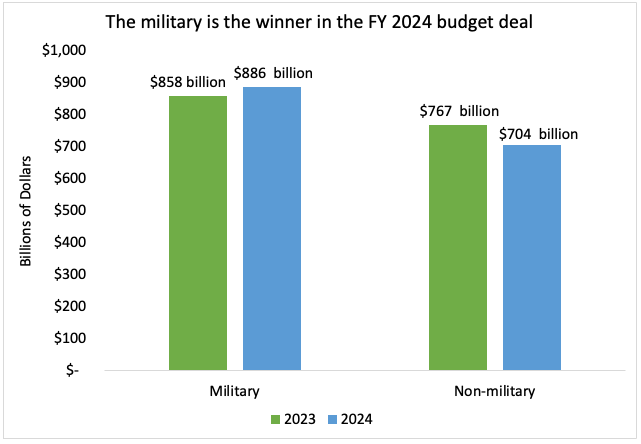Parity, Schmarity: The Budget Deal Gives 56% of the Discretionary Budget to the Military
By
Lindsay Koshgarian
Posted:
|
Budget Process,
Military & Security

Source: CBO’s Estimate of the Budgetary Effects of H.R. 3746, the Fiscal Responsibility Act of 2023
The budget deal struck by the White House and House Republicans could set a damaging precedent shifting federal spending from domestic programs toward the Pentagon.
In setting spending limits for fiscal year 2024, the deal sets military spending at nearly 56 percent of total discretionary spending - $886 billion out of $1.59 trillion. Domestic spending (which includes spending for veterans’ programs) would come in at just $704 billion.
In the current, fiscal year 2023 budget, military spending accounts for 53 percent of discretionary spending. This represents a massive shift of resources away from domestic programs and toward the military: the already-gargantuan military budget will increase by $28 billion (3.3%), while domestic spending will take a cut of $63 billion (8.2%). Cuts to many domestic programs will need to go deeper, because domestic spending includes veterans' programs, which are protected from cuts in the current deal.
This is a blow to a long-standing (if still ill-advised) understanding that when spending limits were on the table, military and non-military spending would both be made to suffer equally.
The understanding, known in DC circles as “parity,” was in fact no such thing: it cemented a status quo where military spending would always get a greater piece of the pie than domestic spending, and where military spending would also get proportionally greater increases than domestic spending.
But the current deal wrecks even that limited notion of “parity” between military and non-military spending. It straight-up shifts money from domestic programs to the military.
If the military had instead received a steady share of the discretionary budget - at about 53 percent, where it is in FY 2023 - that would shift nearly $47 billion from the military back to domestic programs, and make up for most of the $63 billion cut.
The broader deal supposedly includes mechanisms to bolster non-military spending back to its current level, limiting the damage to those programs - and the White House deserves credit for fighting for those mechanisms. But there are some major caveats: first, even a level funding would harm people who are dependent on programs like Head Start or affordable housing programs, because inflation will make the same funding level worth less than it is now. But just as important, these mechanisms aren't included in the legislation working its way through Congress this week. Congress will have to enact them later, and there's no guarantee that will happen.
It’s worth remembering that this deal was not, in fact, necessary at this time. The only reason there’s a budget deal at all right now, is because House Republicans threatened to tank the economy by refusing to allow the U.S. to pay its bills unless they got cuts for programs they don’t like.
They succeeded, and as others have shown, the people to pay the price will be the poorest and most down on their luck. Worse, the current deal could set a new precedent for more of the same: unecessary military increases while domestic programs are slashed.
So much for “parity.”
Note: The discretionary budget is the main or only source of funding for many federal programs, including the military, as well as K-12 public education, affordable housing programs, public health, food and drug safety, environmental protection programs, scientific and medical research, and more. It was also the target of budget negotiations leading up to the current deal. For more on the discretionary budget and federal spending, see our Federal Budget 101.